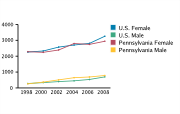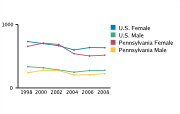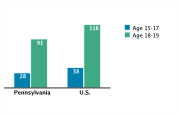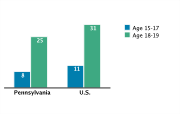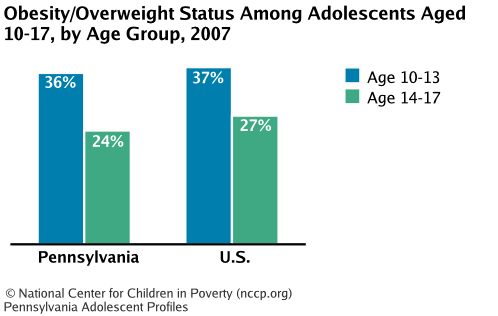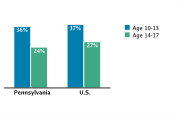| Overview | Health | Mental Health |
State Choices to Promote Access
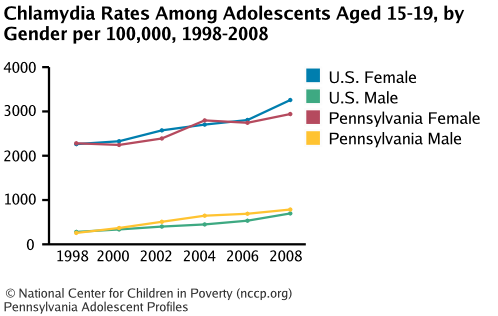
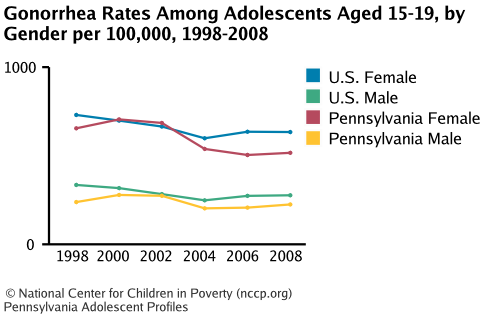
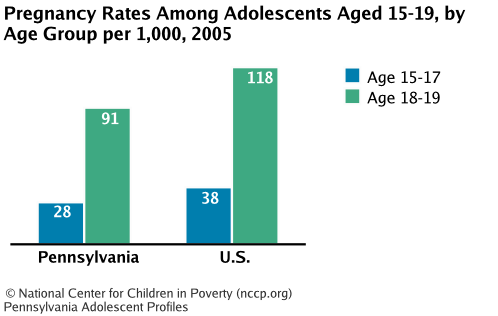

Promotion, Prevention, and Early Intervention
- Extend CHIP to cover legal immigrant children [2010]4
- Maintain or suspend but do not terminate Medicaid enrollment for youth committed to a juvenile facility [2009]5
- Use Chafee funds to provide Medicaid eligibility to foster care youth aging out of the system [2009]6
- Require CHIP coverage for contraceptives [2006]7
- HIV prevention education [2006]8
- STI prevention education [2006]8
- Pregnancy prevention education [2006]8
- Require physical activity and fitness taught in schools [2006]8
Services in Schools
- Provide funding for School-based Health Centers (SBHCs) [2008]9
- Require districts or schools to provide services for HIV, STDs, and pregnancy prevention [2006]10
Law and Legislation
- Prenatal care [2010]11
- Contraceptive and family planning services [2010]12
- HIV and STI prevention and treatment services [2010]11
- Medical care for their own children [2010]11
- Abortion without parental notification or permission [2010]13
State Choices to Promote Quality
Promotion, Prevention, and Early Intervention
- Require or recommend that schools make fruits or vegetables available to students whenever other food is offered or sold [2006]17
- Require or recommend that schools make healthful beverages available to students whenever other beverages are offered or sold [2006]17
- Have statutory nutritional standards for school meal programs beyond federal regulations [2005]18
- Specify time requirements for physical education [2006]19
Services in Schools
- Have a program office dedicated to SBHCs [2008]9
Workforce Development
- Require newly hired health education teachers to have undergraduate or graduate training in health education [2006]20
Data Notes and Sources
Last Updated: June 1, 2011
These state profiles are part of the Improving the Odds for Adolescents project, which is supported by a generous grant from The Atlantic Philanthropies. Contact us with questions or to update your state profile.
- Centers for Disease Control and Prevention, CDC WONDER. Selected STDs by Age, Race/Ethnicity, and Gender, 1996-2008 request. Accessed Aug. 12, 2010, from wonder.cdc.gov/std.html.
- Kost, Kathryn; Henshaw, Stanley; Carlin; Liz. 2010. U.S Teenage Pregnancies, Births and Abortions: National and State Trends and Trends by Race and Ethnicity, Guttmacher Institute. Accessed Aug. 12, 2010, from www.guttmacher.org/pubs/USTPtrends.pdf.
- Children's Health Coverage State Fact Sheets, Children's Defense Fund. Children's Defense Fund website. Accessed Feb. 2, 2010, from www.childrensdefense.org/child-research-data-publications/data/state-data-repository/childrens-health-coverage-state-factsheets.html.
- National Immigration Law Center, Guide to Immigrant Eligibility for Federal Programs: Update Page. 2010. Medical Assistance Programs for Immigrants in Various States. Accessed Aug. 2, 2010, from www.nilc.org/pubs/guideupdates/med-services-for-imms-in-states-2010-07-28.pdf.
Wiley, Dinah, National Immigration Law Center. Aug. 2, 2010. Personal communication. - Kaye, Neva; Zemel, Sarabeth. 2009. Medicaid Eligibility, Enrollment, and Retention Policies: Findings from a Survey of Juvenile Justice and Medicaid Policies Affecting Children in the Juvenile Justice System (Models for Change: Systems Reform in Juvenile Justice). National Academy for State Health Policy. Accessed July 21, 2010, from www.nashp.org/sites/default/files/MacFound11-09.pdf.
Personal communication with state agency: includes private letters, memos, some electronic communication (i.e. email, personal interviews, or telephone conversations). - Kaiser Commission on Medicaid and the Uninsured, Challenges of Providing Health Coverage for Children and Parents in a Recession: A 50 State Update on Eligibility Rules, Enrollment and Reneweal Procedures, and Cost-Sharing Practices in Medicaid and SCHIP in 2009. State Income Eligibility Guidelines for Children's Regular Medicaid, Children's SCHIP-funded Medicaid Expansions and Separate SCHIP Programs (Percent of the Federal Poverty Line) January 2009. (Table 1). Accessed Aug. 16, 2010, from www.kff.org/medicaid/upload/7855_TABLES.pdf.
- Gold, Rachel Benson; Sonfield, Adam. 2001. Reproductive Health Services for Adolescents Under the State Children's Health Insurance Program. Family Planning Perspectives 33(2):83-87.
Medicaid Cuts: Benefits May Be Reduced for Women. 2006. National Women's Law Center website. Accessed Mar. 5 2010, from www.nwlc.org/pdf/FSMedicaidandtheDRA_04.21.06.pdf. - Centers for Disease Control and Prevention, State-Level School Health Policies and Practices. A State-by-State Summary from the School Health Policies and Programs Study 2006. Table 1.5. Accessed July 29, 2010, from www.cdc.gov/HealthyYouth/SHPPS/2006/summaries/pdf/State_Level_Summaries_SHPPS2006.pdf.
Centers for Disease Control and Prevention, State-Level School Health Policies and Practices. A State-by-State Summary from the School Health Policies and Programs Study 2006. Table 1.6. Accessed July 29, 2010, from www.cdc.gov/HealthyYouth/SHPPS/2006/summaries/pdf/State_Level_Summaries_SHPPS2006.pdf. - Schlitt, John J.; Juszczak, Linda J.; Eichner, Nancy Haby. 2008. Current Status of State Policies that Support School-Based Health Centers. Public Health Reports 123(6): 731-738.
- Centers for Disease Control and Prevention, State-Level School Health Policies and Practices. A State-by-State Summary from the School Health Policies and Programs Study 2006. Table 3.3. Accessed July 29, 2010, from www.cdc.gov/HealthyYouth/SHPPS/2006/summaries/pdf/State_Level_Summaries_SHPPS2006.pdf.
- English, Abigail; Bass, Lindsay; Boyle, Alison Dame; Eshragh, Felicia. 2010. State Minor Consent Laws: A Summary, 3rd Edition. Center for Adolescent Health and the Law.
- No explicit policy, but minors may be able to consent to care based on the constitutional right of privacy, if the site is funded under the federal Title X Family Planning Program, or services are paid for by Medicaid.
English, Abigail; Bass, Lindsay; Boyle, Alison Dame; Eshragh, Felicia. 2010. State Minor Consent Laws: A Summary, 3rd Edition. Center for Adolescent Health and the Law. - Except in cases of medical emergency or judicial bypass.
English, Abigail; Bass, Lindsay; Boyle, Alison Dame; Eshragh, Felicia. 2010. State Minor Consent Laws: A Summary, 3rd Edition. Center for Adolescent Health and the Law. - Centers for Disease Control and Prevention, Childcare and School Vaccination Requirements. 2008. Summary of Vaccination Requirements by Vaccine or Antigen 2007-2008. Accessed Aug. 16, 2010, from www2a.cdc.gov/nip/schoolsurv/CombinedLaws2007.pdf.
- Body Mass Index (BMI) is a number calculated from a child's weight and height and is a reliable indicator of body fatness for most children and adolescents. BMI for children and adolescents, also referred to as BMI-for-age, is gender and age specific because their body fatness changes over the years as they grow and differs between males and females. Adolescents in the 85th to 94th percentile BMI-for-age were classified as overweight. Those in the 95th percentile or above BMI-for-age were classified as obese.
Child and Adolescent Health Measurement Initiative. 2007 National Survey of Children's Health, Data Resource Center for Child and Adolescent Health website. Accessed Aug. 12, 2010, from nschdata.org/DataQuery/DataQueryResultsAllStates.aspx?validq=1. - U.S. Department of Health and Human Services, Centers for Medicare and Medicaid Services. 2009. The Annual EPSDT Report (Form CMS-416). Accessed July 27, 2010, from www.cms.gov/MedicaidEarlyPeriodicScrn/downloads/508_416_Form_3-05.pdf.
- Centers for Disease Control and Prevention. 2007. State-Level School Health Policies and Practices: A State-by-State Summary from the School Health Polices and Programs Study 2006. Table 5.5. Accessed Nov. 18, 2009, from www.cdc.gov/HealthyYouth/shpps/2006/summaries/pdf/State_Level_Summaries_SHPPS2006.pdf.
- State Policies Related to Student Health and Nutrition. 2005. Education Commission of the States website. Accessed Feb. 3, 2010, from www.ecs.org/clearinghouse/61/75/6175.htm.
- Centers for Disease Control and Prevention. 2007. State-Level School Health Policies and Practices: A State-by-State Summary from the School Health Polices and Programs Study 2006. Table 2.9. Accessed Nov. 18, 2009, from www.cdc.gov/HealthyYouth/shpps/2006/summaries/pdf/State_Level_Summaries_SHPPS2006.pdf.
- Centers for Disease Control and Prevention. 2007. State-Level School Health Policies and Practices: A State-by-State Summary from the School Health Policies and Programs Study 2006. Table 1.11. Accessed Nov. 18, 2009, from www.cdc.gov/HealthyYouth/shpps/2006/summaries/pdf/State_Level_Summaries_SHPPS2006.pdf.

